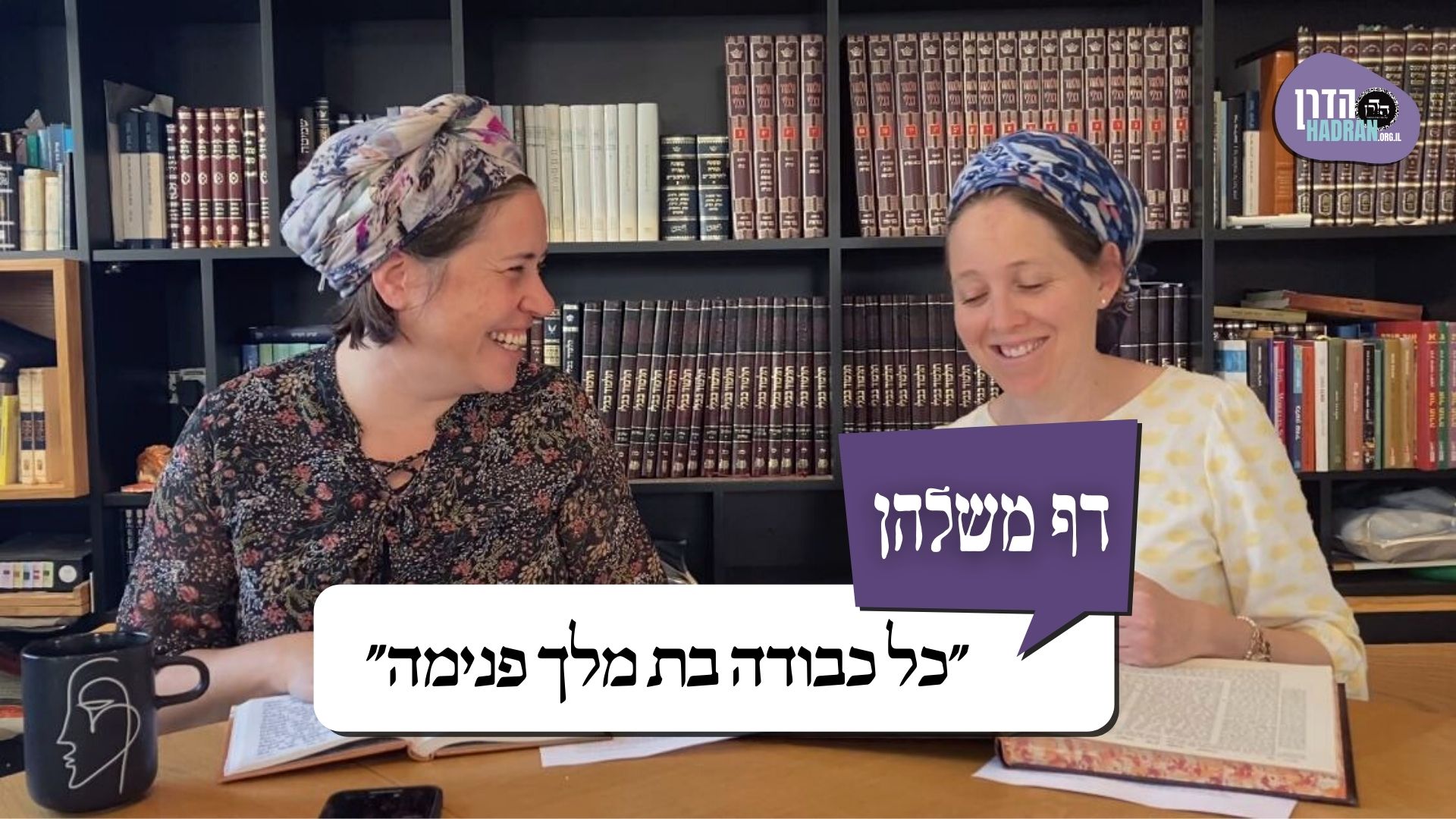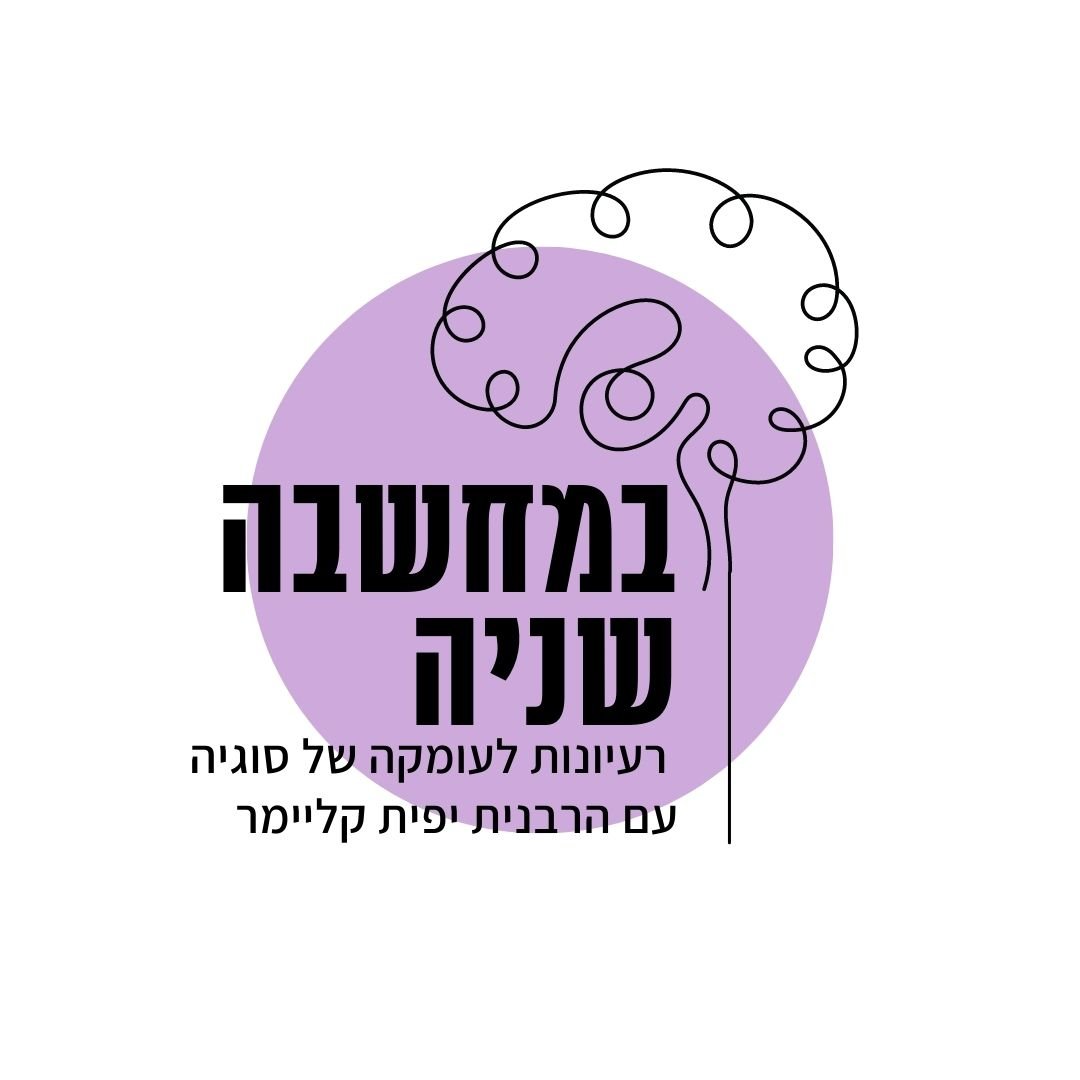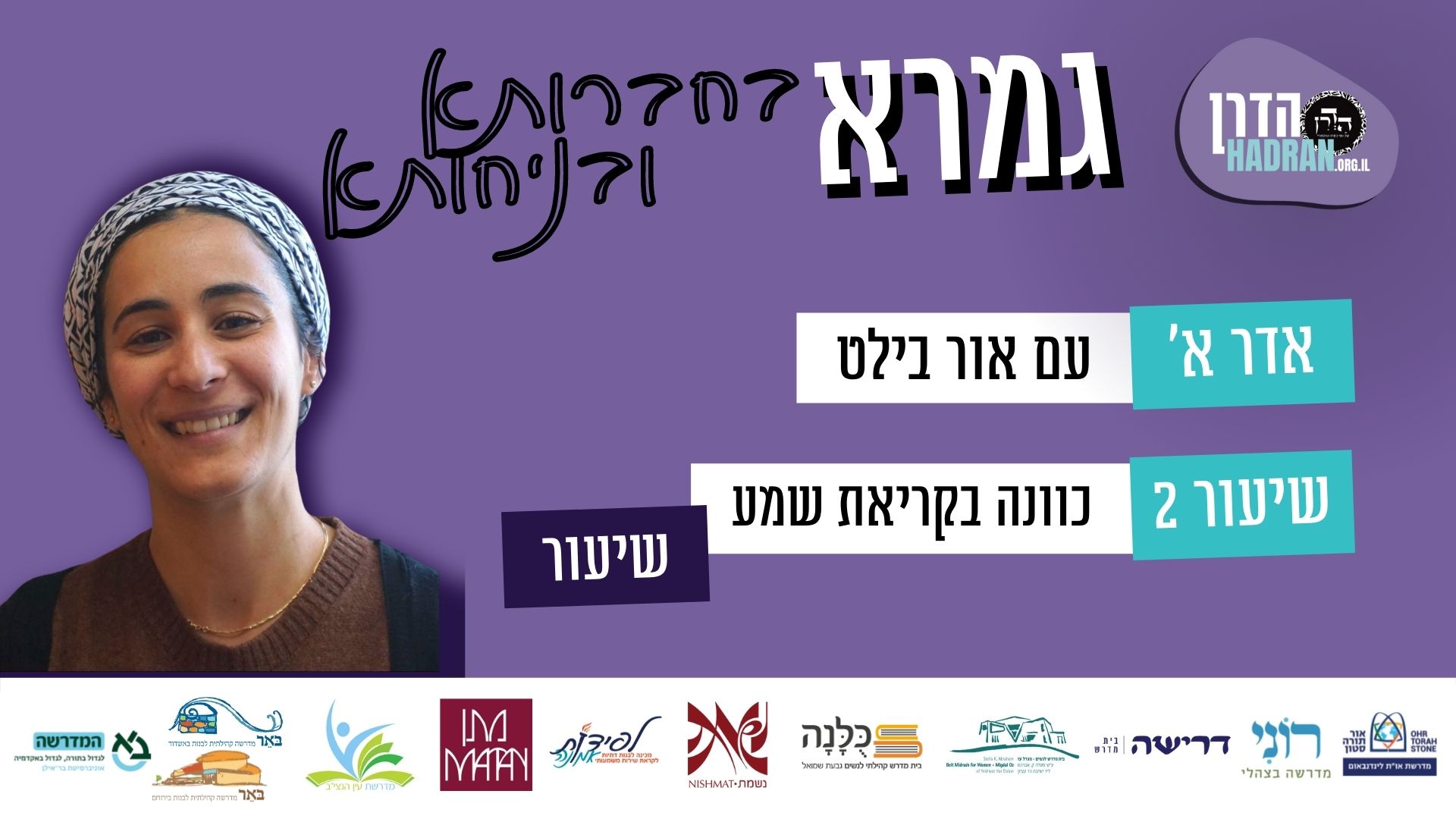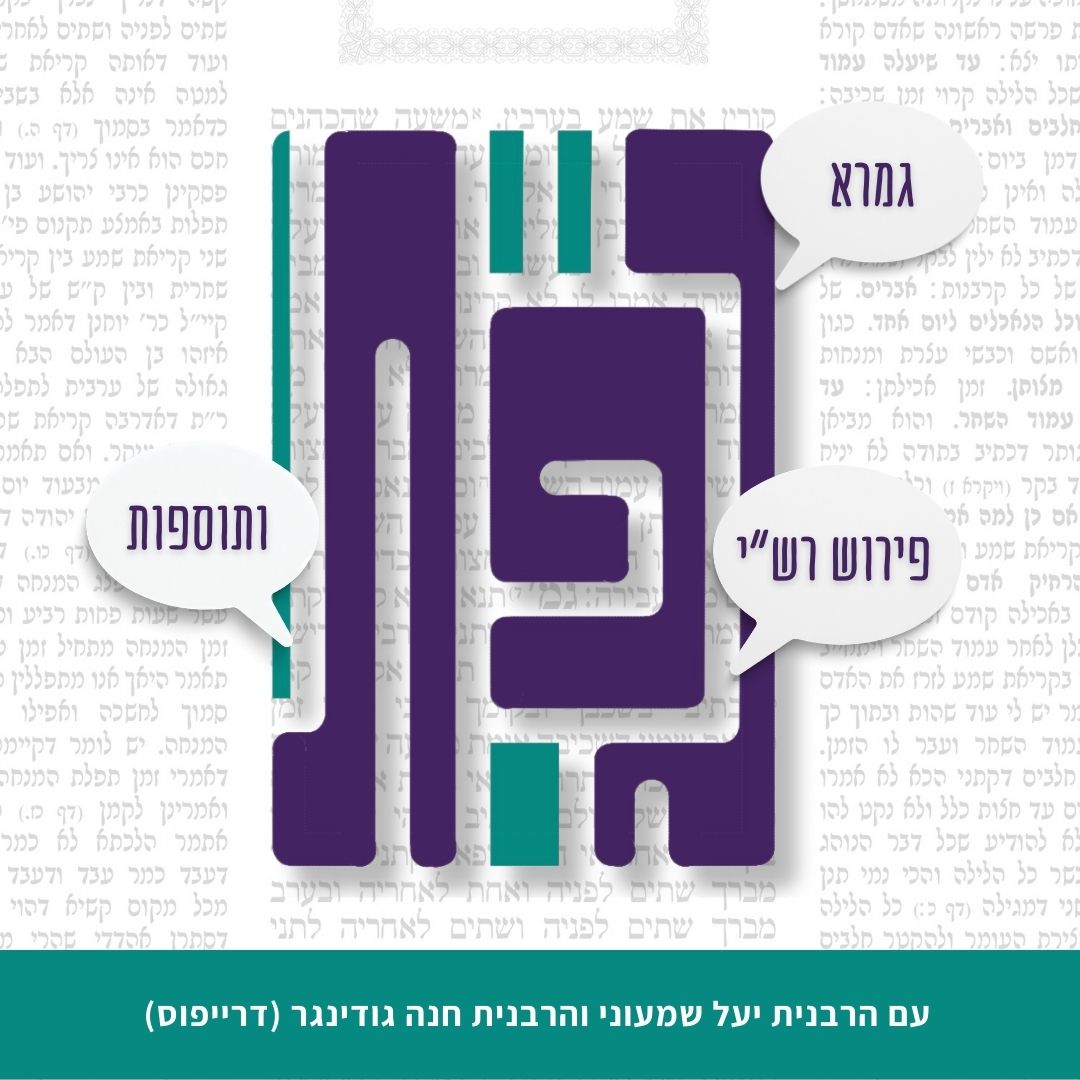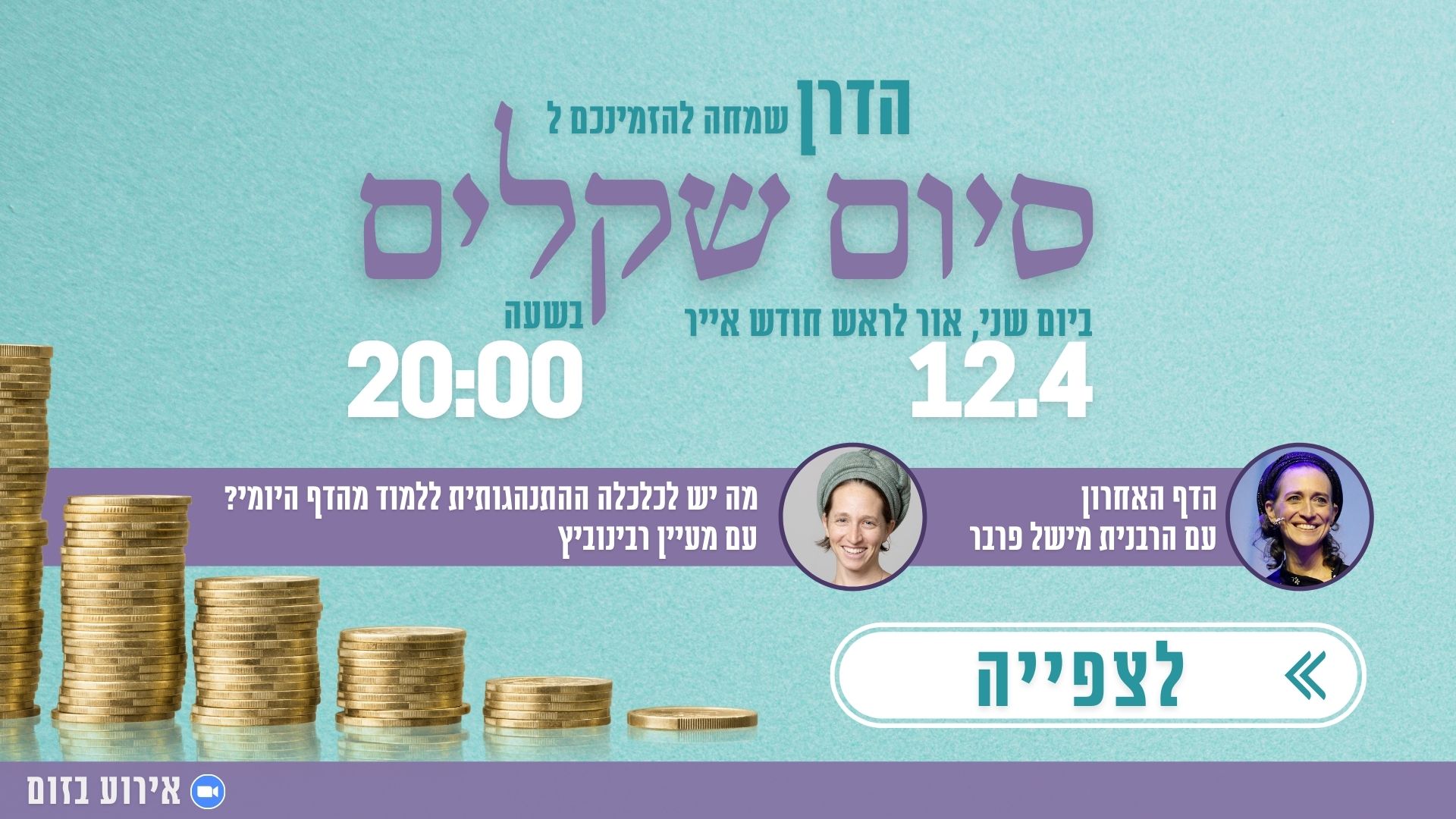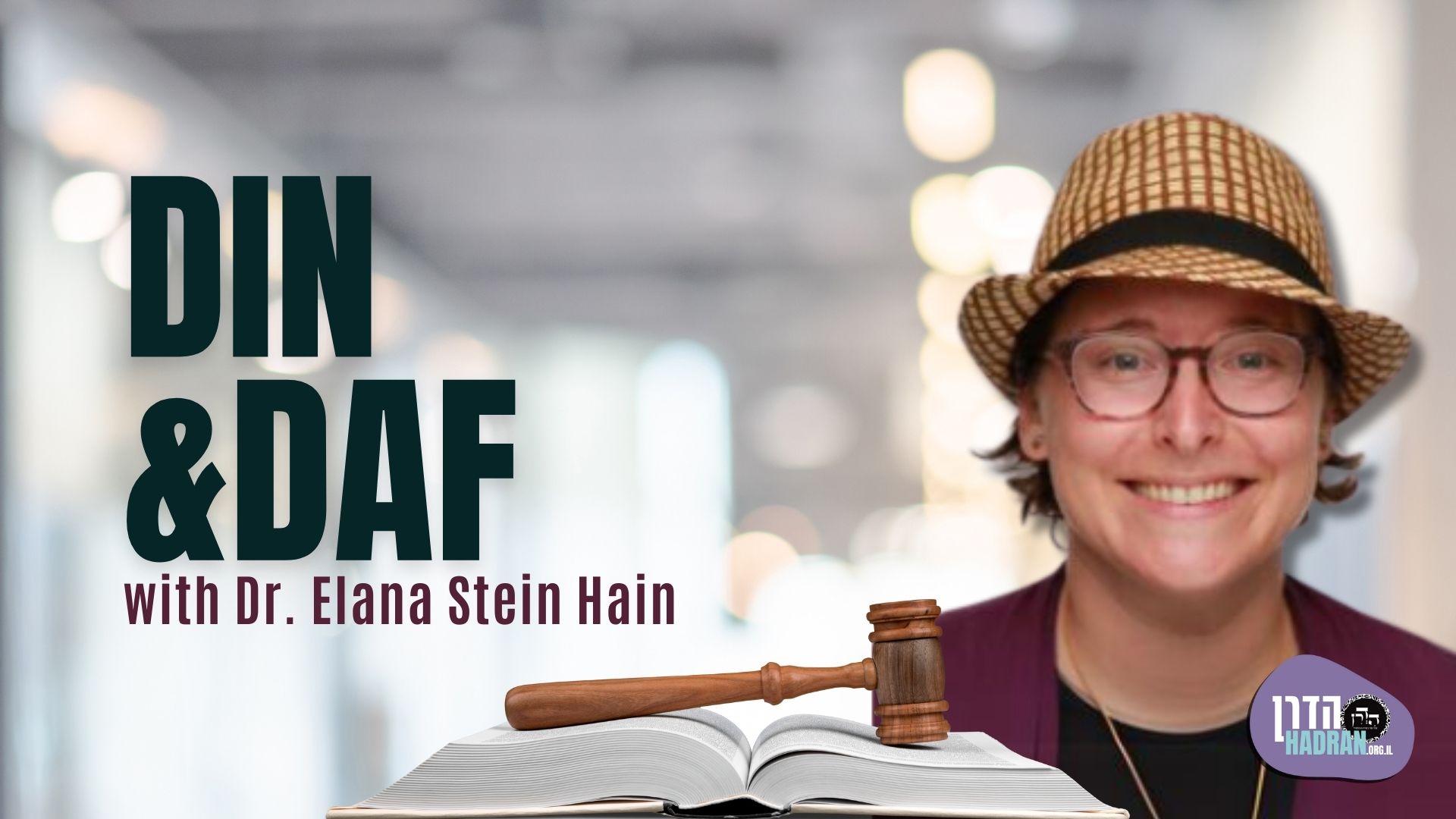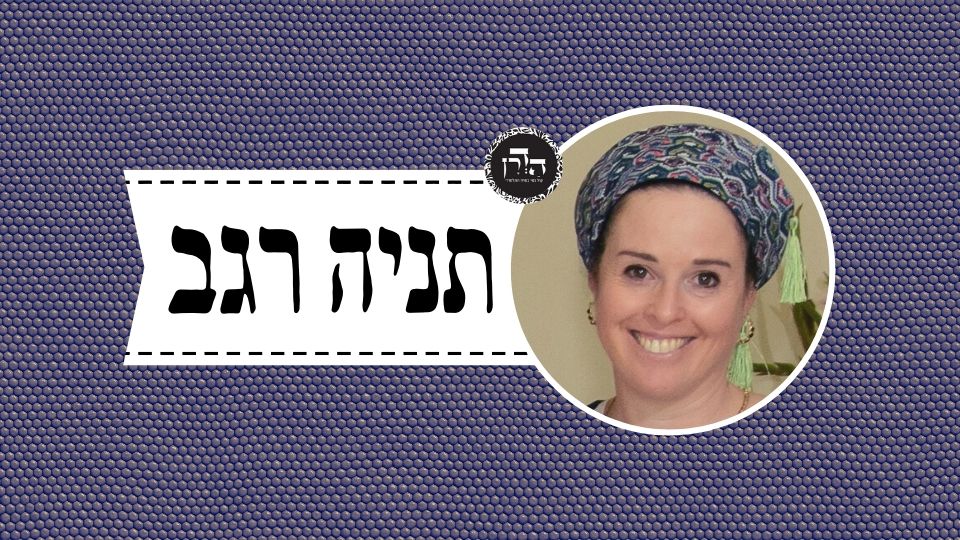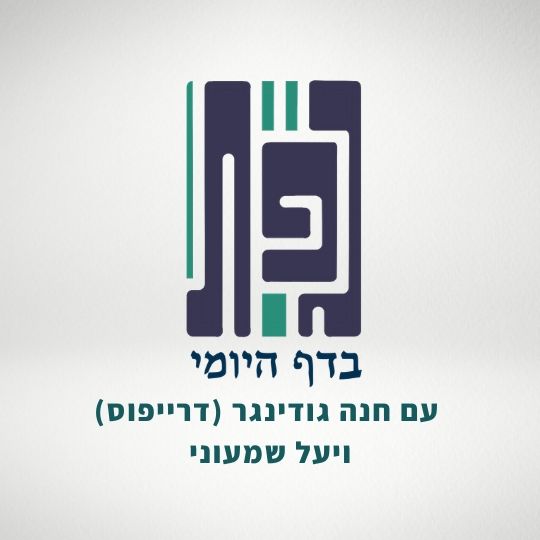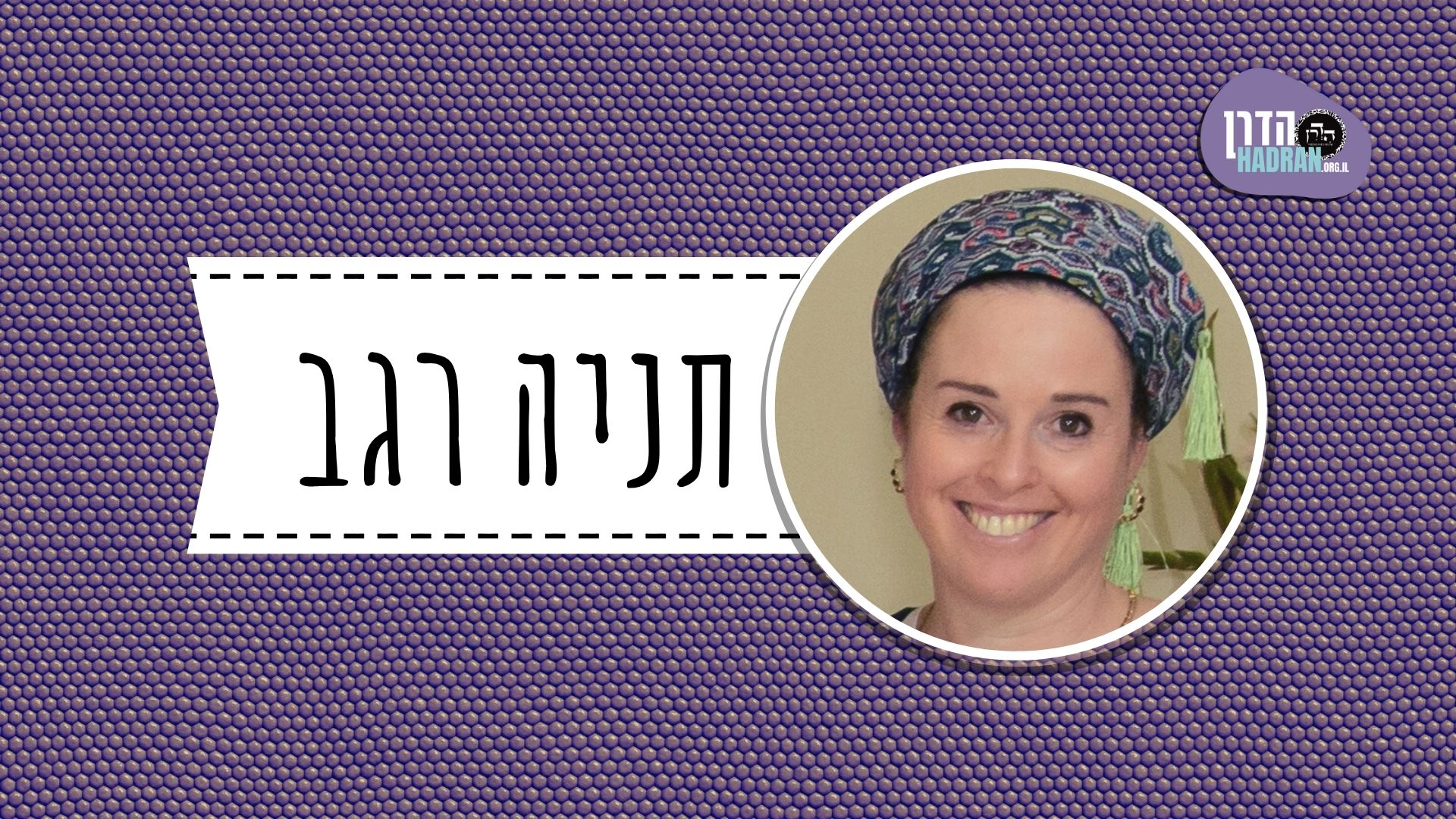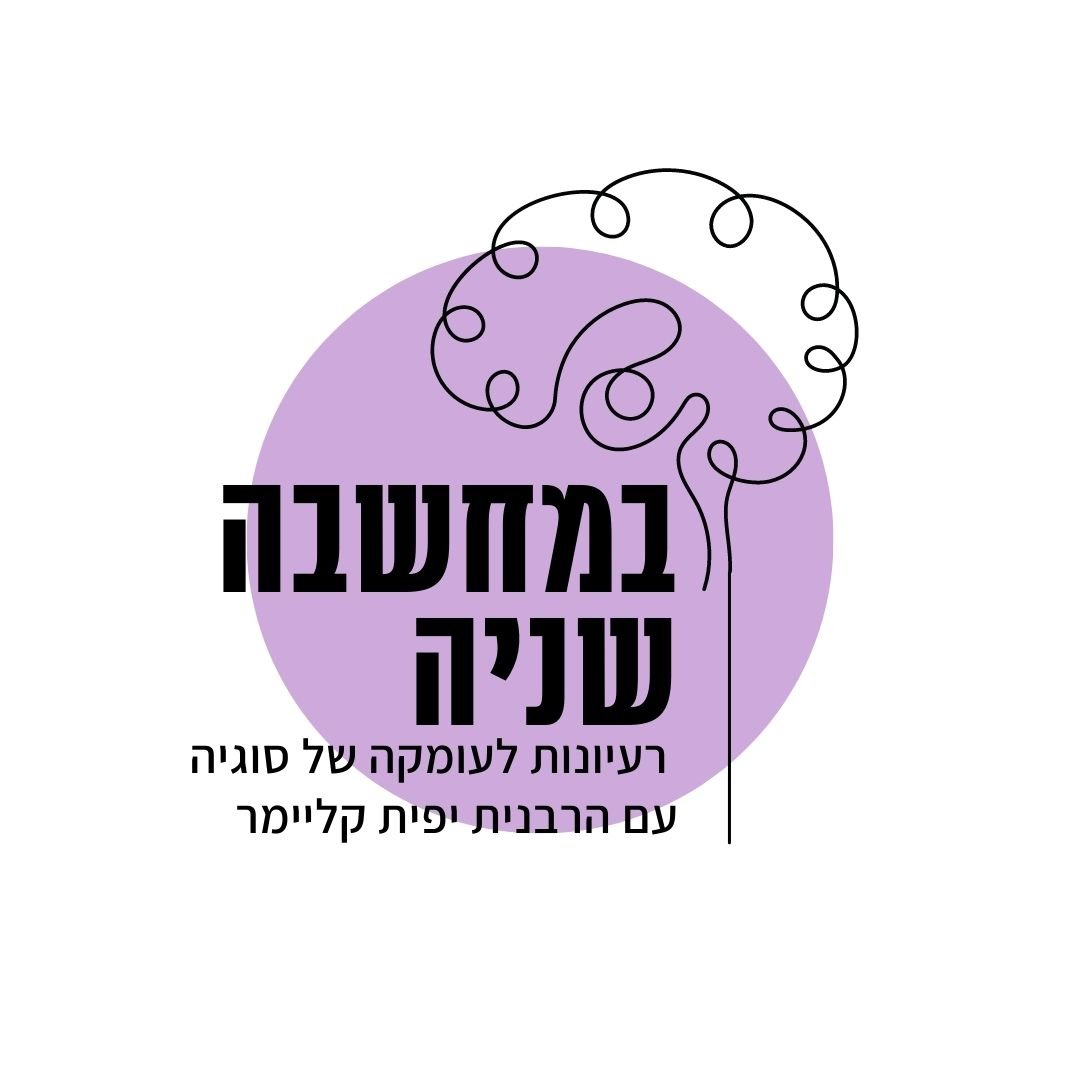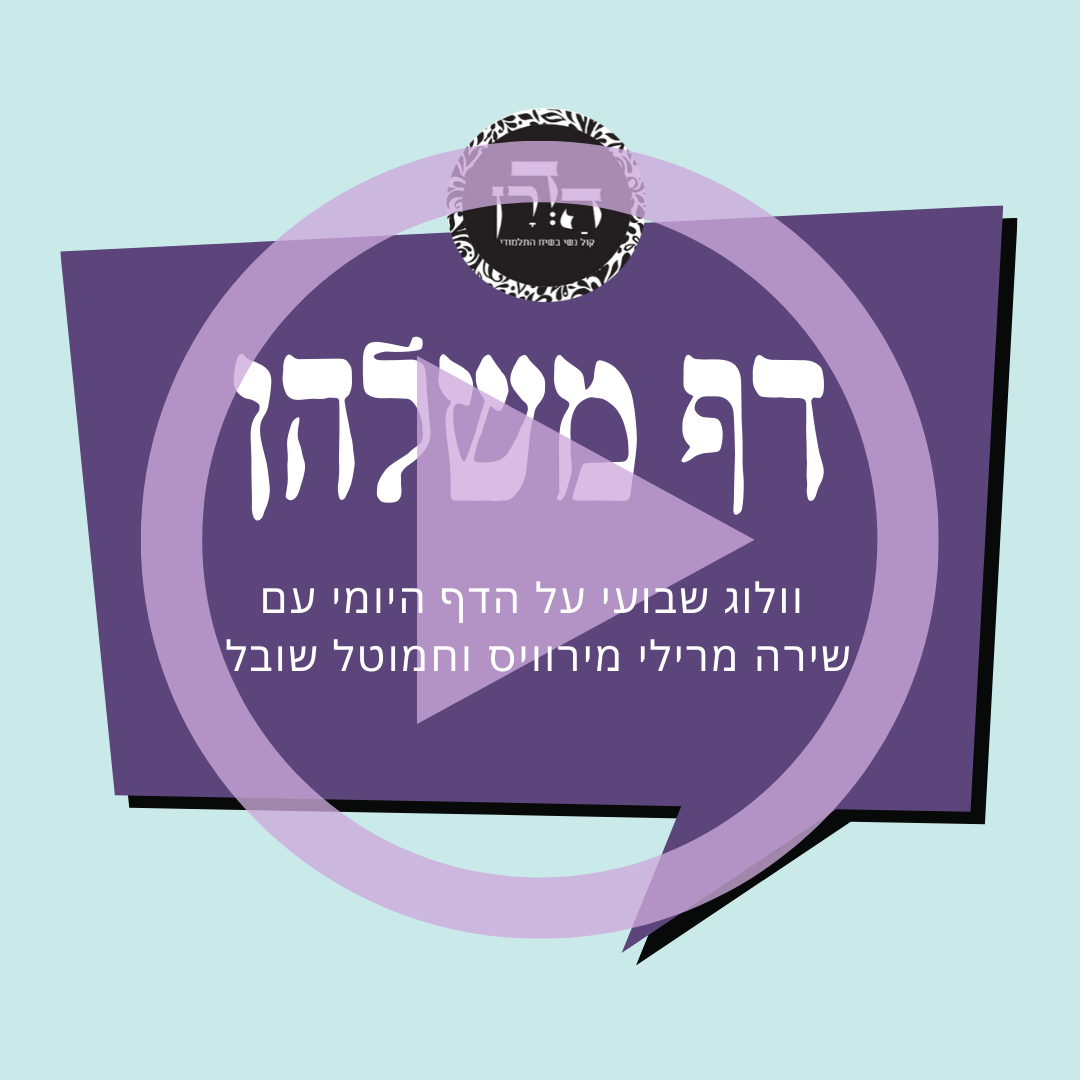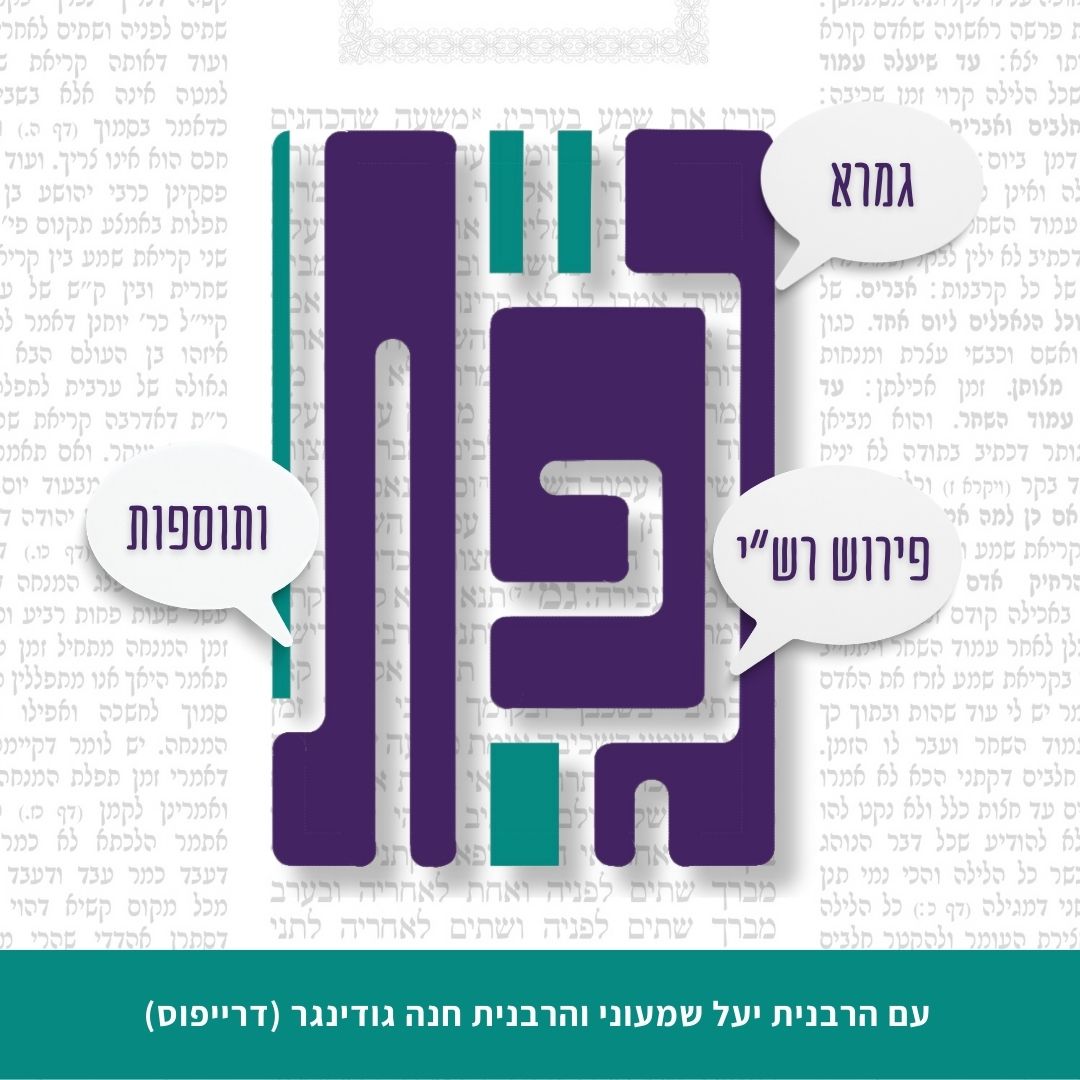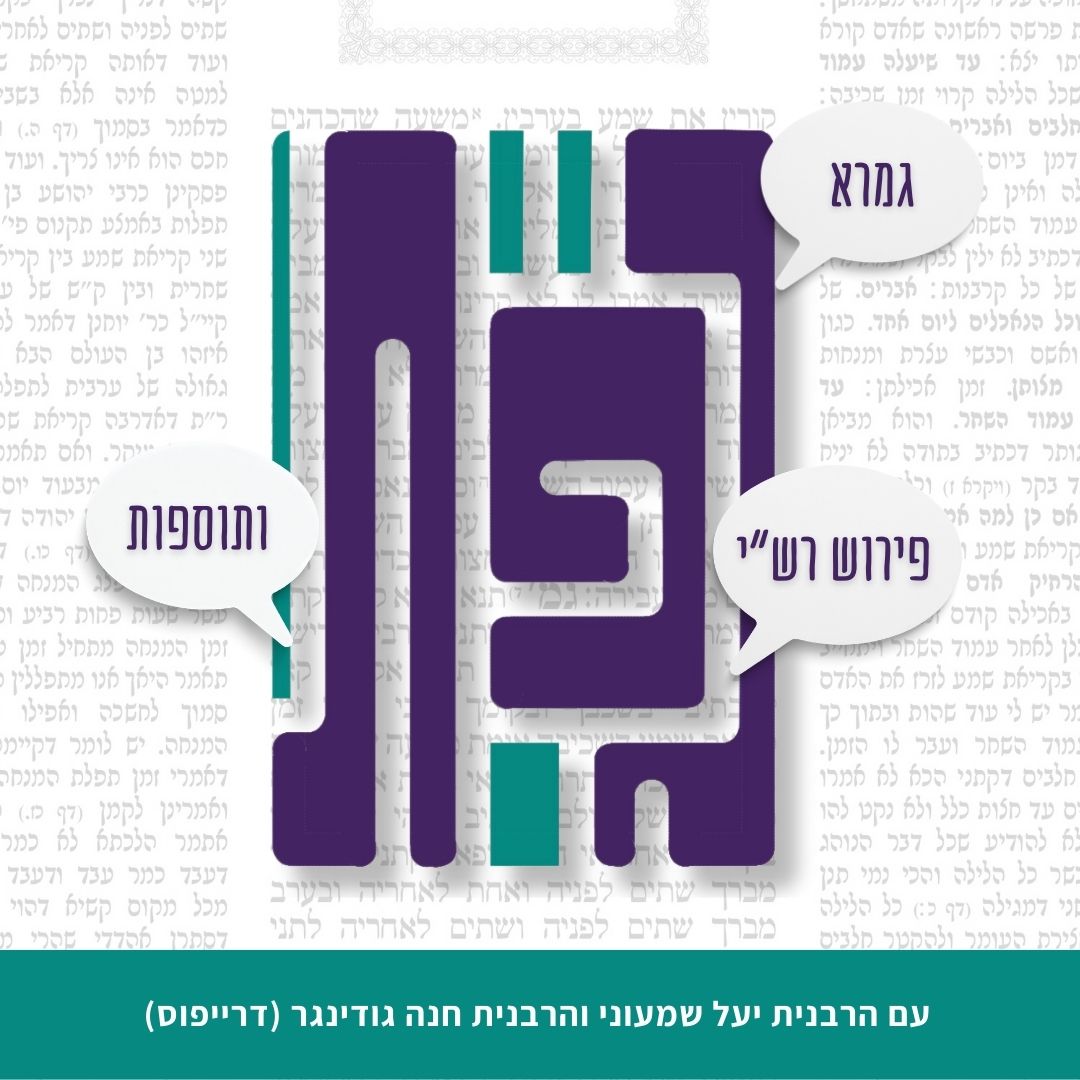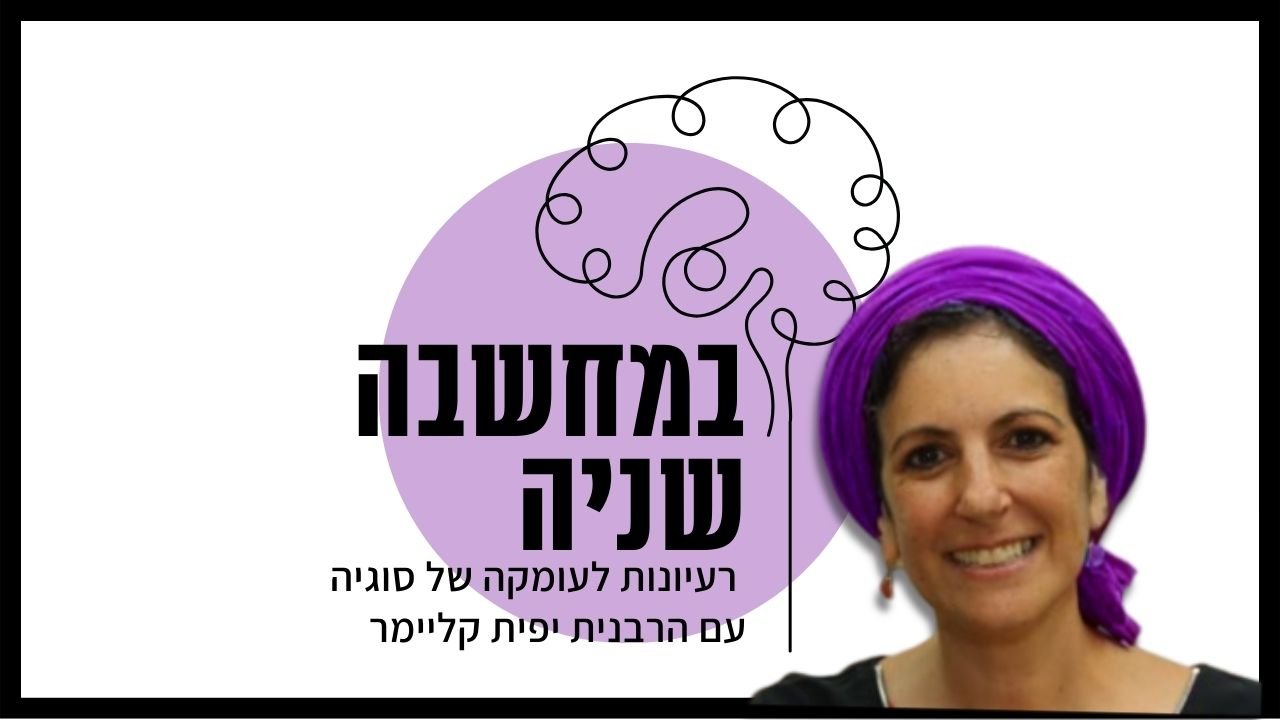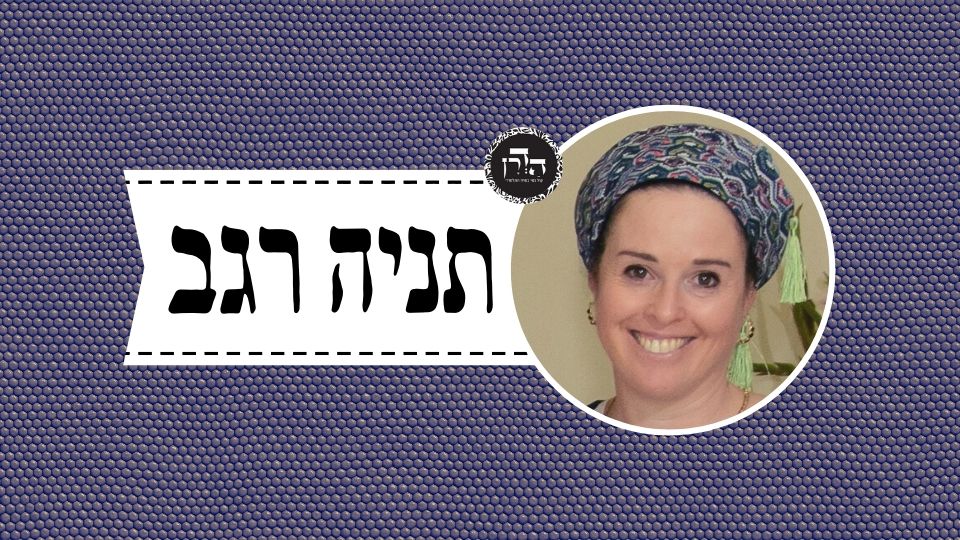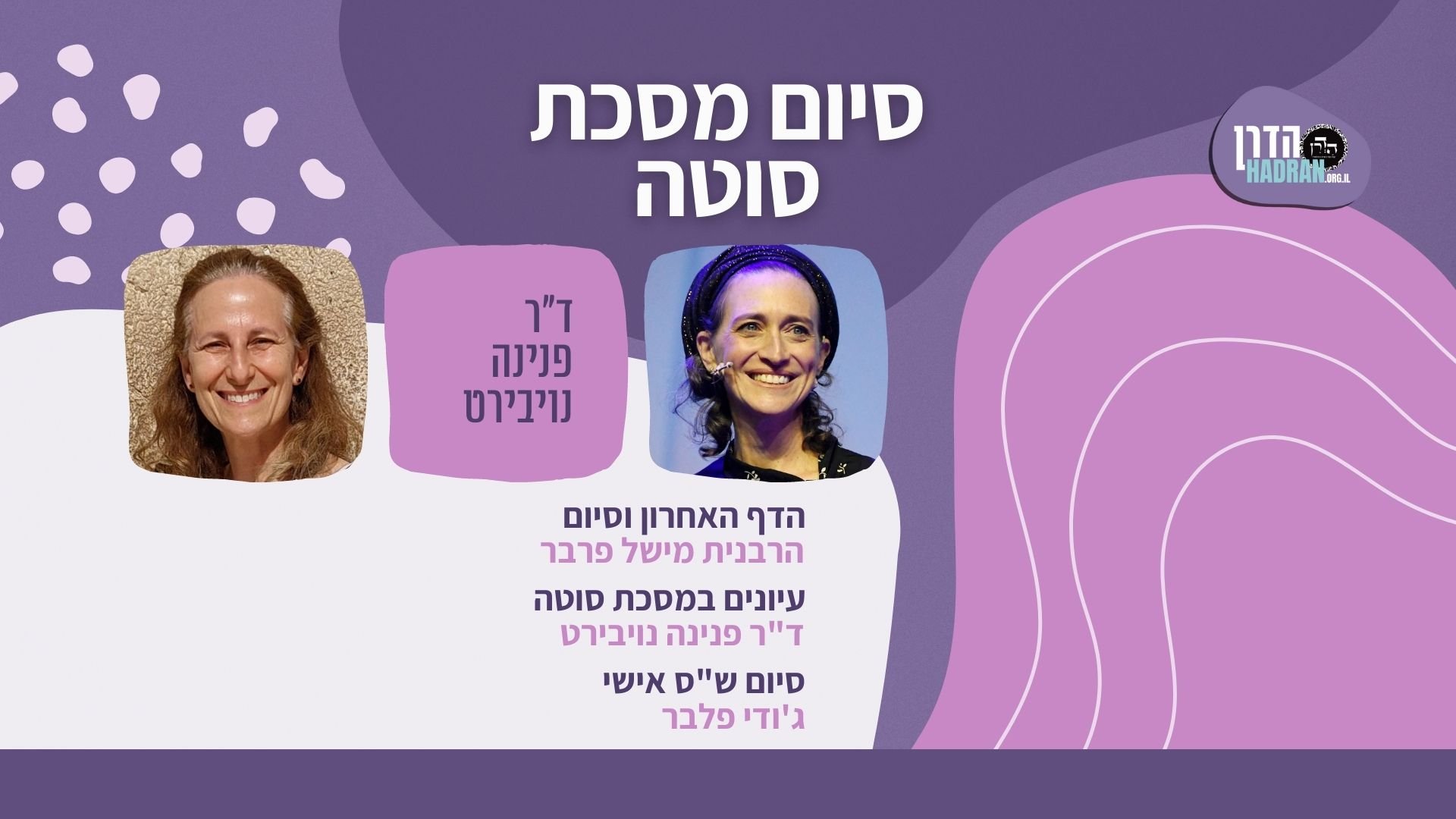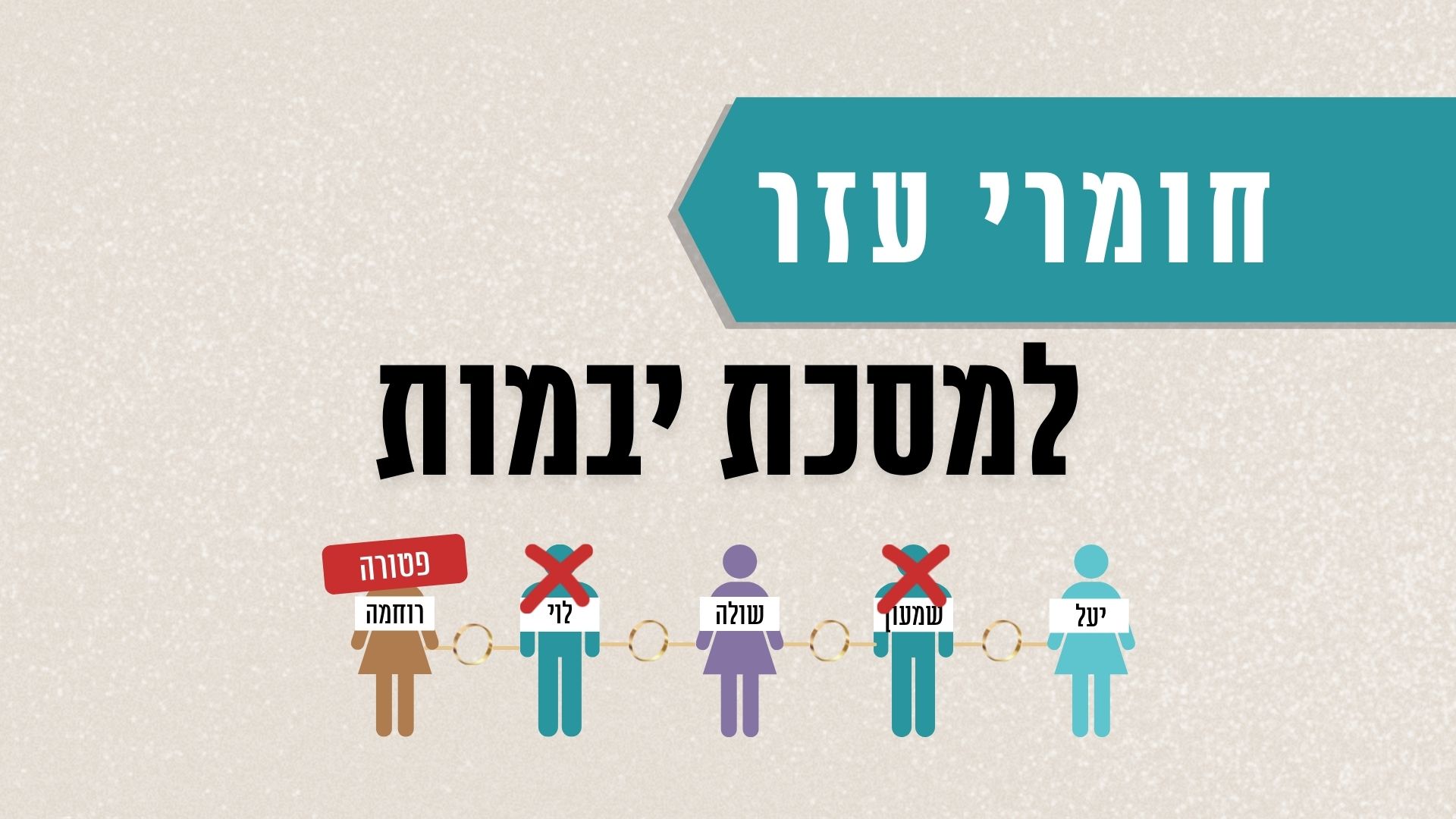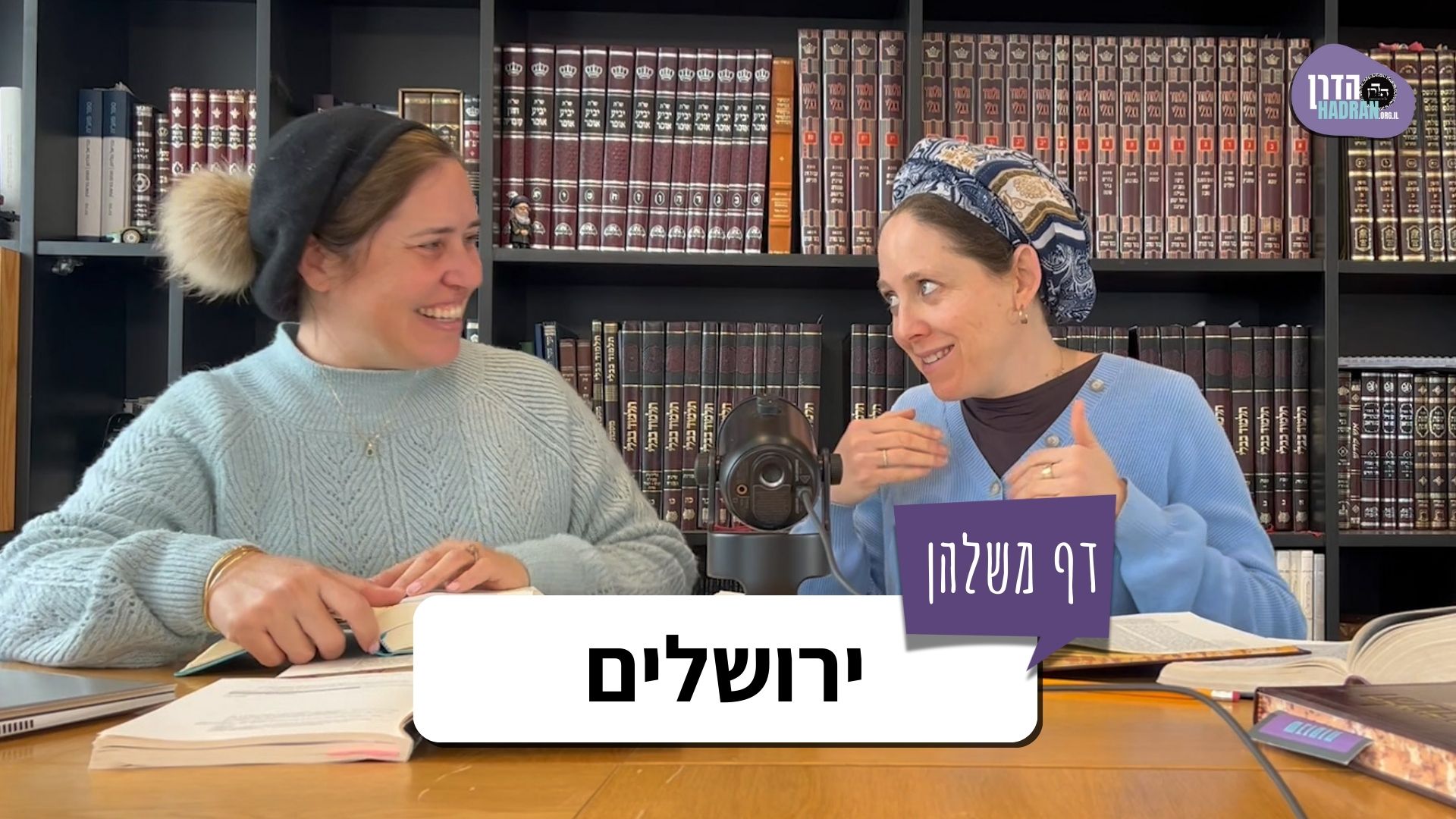המשנה מתארת המשך הבוקר – הטלת הפייסות – מהן התפקידים שהפיסו? מתי יכלו להתחיל העבודה ואיך ידעו שהגיעה השעה הזאת? איך פתחו שערי ההיכל? הראשונים שנכנסו הלכו לדשן מזבח פנימי ומנורה. באותו זמן הכהן הלך לשחוט את התמיד בבית המטבחיים.
רוצה להקדיש שיעור?
כלים
העמקה
רוצה להבין מה באמת קורה מתחת לפני השטח של הסוגיה?
שיעורים, פודקאסטים והרחבות של מיטב המורות שלנו יפתחו לך עוד זוויות וכיווני חשיבה.
חדשה בלימוד הגמרא?
זה הדף הראשון שלך? איזו התרגשות עצומה! יש לנו בדיוק את התכנים והכלים שיעזרו לך לעשות את הצעדים הראשונים ללמידה בקצב וברמה שלך, כך תוכלי להרגיש בנוח גם בתוך הסוגיות המורכבות ומאתגרות.
פסיפס הלומדות שלנו
גלי את קהילת הלומדות שלנו, מגוון נשים, רקעים וסיפורים. כולן חלק מתנועה ומסע מרגש ועוצמתי.
תמיד ל
וְשָׁיְיפִי לְהוּ בְּחַבְלָא דְּצַבְתָּא דִּסְרִיךְ עֲלֵיהּ בִּזְרָא, וְקָבְרִי הֵיכָא דְּמַסֵּיק יַמָּא שִׂירְטוֹן, קוֹרָה – עָבְדָא, פֵּירֵי – לָא עָבְדָא, וּתְלָת בְּרִיכֵי מִינַּיְיהוּ לָא מַחְזְקָה לְהוּ גַּמְלָא.
and the growers rub them with a rope made of palm fronds, to which the seeds adhere, and they plant the tree in a spot where the sea emits deposits of sediment [sirton]. A tree planted in this manner produces wood that is suitable for a beam, but it does not produce fruit. And as the tree does not divert its resources to yielding fruit, its wood is so robust and heavy that with regard to three of its branches, a bridge cannot support them.
סִידֵּר אֶת הַמַּעֲרָכָה גְּדוֹלָה וְכוּ׳. מַאי טַעְמָא? רַב הוּנָא וְרַב חִסְדָּא. חַד אָמַר: כְּדֵי שֶׁתְּהֵא הָרוּחַ מְנַשֶּׁבֶת בָּהּ, וְחַד אָמַר: כְּדֵי שֶׁיְּהוּ מַצִּיתִין הָאֲלִיתָא מִשָּׁם.
§ The mishna teaches: The priest assembled the large arrangement on the eastern side of the altar, and its opening was on the eastern side of the altar. The Gemara asks: What is the reason that an opening was formed in the arrangement? This matter is subject to a dispute between Rav Huna and Rav Ḥisda: One said that the opening was formed so that the wind would blow into it and fan the flames of the arrangement. And one said that it was formed so that the priests would be able to light from there the kindling that was placed between the logs.
מֵיתִיבִי: רֶיוַח הָיָה בָּהֶן בֵּין הַגְּזִירִין, שֶׁהָיוּ מַצִּיתִין הָאֲלִיתָא מִשָּׁם. אָמַר לָךְ, מְקוֹמוֹת מְקוֹמוֹת עָבְדִי.
The Gemara raises an objection from the mishna: There was space between the logs, as the priests would ignite the kindling from there. Evidently, the kindling was not ignited from the opening. The Gemara explains: The Sage who maintains that the kindling was lit from the opening in the east of the arrangement could say to you that in addition to lighting kindling from the opening, the priests would fashion many spaces within the arrangement, through which they would ignite kindling in order to increase the fire.
הֲדַרַן עֲלָךְ רָאוּהוּ אֶחָיו
אָמַר לָהֶן הַמְמוּנֶּה בּוֹאוּ וְהָפִיסוּ: מִי הַשּׁוֹחֵט, וּמִי הַזּוֹרֵק, מִי מְדַשֵּׁן מִזְבֵּחַ הַפְּנִימִי, מִי מְדַשֵּׁן אֶת הַמְּנוֹרָה, מִי מַעֲלֶה אֵבָרִים לַכֶּבֶשׁ.
MISHNA: 3:1 Four lotteries were conducted in the Temple each day in order to determine which priests would perform which of the Temple rites. After describing the first of the lotteries, for removal of the ashes, the tanna describes the second lottery. The priest appointed to oversee the lotteries said to the priests: Come and participate in the lottery to determine who is the priest who will slaughter the daily offering; and who is the priest who will sprinkle its blood; and who will remove the ashes from the inner, golden altar; and who will remove the ashes from the Candelabrum; and who will take the limbs of the daily offering up to the ramp to be burned afterward.
הָרֹאשׁ וְהָרֶגֶל שֶׁל יָמִין, וּשְׁתֵּי הַיָּדַיִם, הָעוֹקֶץ וְהָרֶגֶל שֶׁל שְׂמֹאל, הֶחָזֶה וְהַגֵּרָה, וּשְׁתֵּי דְפָנוֹת, הַקְּרָבַיִים, וְהַסּוֹלֶת, וְהַחֲבִיתִּין וְהַיַּיִן.
The limbs of the daily offering taken up to the ramp were divided among the priests in the following manner: One priest took the head and the right hind leg up to the altar; and a second took the two forelegs; a third the haunch, including the lower spine and the tail, and the left hind leg; a fourth the breast and the cud, i.e., the neck and appended internal organs, including the windpipe, liver, and heart; and a fifth the two flanks; a sixth the innards; and a seventh the fine flour from the accompanying meal offering; and an eighth the griddle-cake offering; and a ninth the wine for the libation.
הֵפִיסוּ, זָכָה מִי שֶׁזָּכָה.
They conducted the lottery to determine the thirteen tasks, i.e., slaughtering, carrying the nine items or pairs of items, sprinkling the blood, removing the ashes from the inner altar, and removing the ashes from the Candelabrum. And whoever won that lottery won the right to perform the slaughter, and the twelve priests standing to his right won the other privileges.
אָמַר לָהֶן: צְאוּ וּרְאוּ אִם הִגִּיעַ זְמַן שְׁחִיטָה. אִם הִגִּיעַ, הָרוֹאֶה אוֹמֵר: ״בַּרְקַאי״. מַתְיָא בֶּן שְׁמוּאֵל אוֹמֵר: הֵאִיר פְּנֵי כׇּל הַמִּזְרָח עַד שֶׁהוּא בְּחֶבְרוֹן? וְהוּא אוֹמֵר: ״הֵן״.
MISHNA 3:2 The appointed one said to the priests: Go out and observe if it is day and the time for slaughter has arrived. If the time has arrived, the observer says: There is light. Matya ben Shmuel says that the appointed priest phrased his question differently, saying: Is the entire eastern sky illuminated as far as Hebron? And the observer says: Yes.
אָמַר לָהֶן: צְאוּ וְהָבִיאוּ (לִי, וְהוֹצִיאוּ) טָלֶה מִלִּשְׁכַּת הַטְּלָאִים. וַהֲרֵי לִשְׁכַּת הַטְּלָאִים נְתוּנָה בְּמִקְצוֹעַ צְפוֹנִית מַעֲרָבִית. אַרְבַּע לְשָׁכוֹת הָיוּ שָׁם: אַחַת – לִשְׁכַּת הַטְּלָאִים, וְאַחַת – לִשְׁכַּת הַחוֹתָמוֹת, וְאַחַת – לִשְׁכַּת בֵּית הַמּוֹקֵד, וְאַחַת – לִשְׁכָּה שֶׁעוֹשִׂין בָּהּ לֶחֶם הַפָּנִים.
MISHNA 3:3 The appointed priest said to the priests: Go out and bring me a lamb from the Chamber of the Lambs, where lambs that had been examined and found to be unblemished were kept. And the Chamber of the Lambs is located in the northwestern corner of the building of the Chamber of the Hearth. There were four chambers there, in that building: One was the Chamber of the Lambs; and one was the Chamber of the Seals, located in the northeastern corner, where the priest stored receipts given to those seeking to purchase animal offerings; and one was the Chamber of the Hearth, where there was a fire burning to warm the priests; and the last one was the chamber in which the priests prepared the shewbread.
נִכְנְסוּ לְלִשְׁכַּת הַכֵּלִים, הוֹצִיאוּ מִשָּׁם תִּשְׁעִים וּשְׁלֹשָׁה כְּלֵי כֶסֶף וּכְלֵי זָהָב, הִשְׁקוּ אֶת הַתָּמִיד בַּכּוֹס
MISHNA 3:4 The priests entered the Chamber of the Vessels, where the service vessels required for the daily Temple service were stored. They took out from there ninety-three silver vessels and gold vessels. They then gave the lamb selected for the daily offering water to drink in a cup
שֶׁל זָהָב. אַף עַל פִּי שֶׁהוּא מְבוּקָּר מִבָּעֶרֶב – מְבַקְּרִין אוֹתוֹ לְאוֹר אֲבוּקוֹת.
of gold. Although the lamb was examined and deemed unblemished earlier in the evening, the priests examine it now by the light of the torches.
מִי שֶׁזָּכָה בְּדִישּׁוּן מִזְבֵּחַ הַפְּנִימִי וּבְדִישּׁוּן הַמְּנוֹרָה, הָיוּ מַקְדִּימִין, וְאַרְבָּעָה כֵּלִים בְּיָדָם: הַטְּנִי וְהַכּוּז וּשְׁנֵי מַפְתְּחוֹת. הַטְּנִי – דּוֹמֶה לְתַרְקַב שֶׁל זָהָב מַחֲזִיק קַבַּיִים וָחֵצִי. וְהַכּוּז – דּוֹמֶה לְקִיתוֹן גָּדוֹל שֶׁל זָהָב. וּשְׁתֵּי מַפְתְּחוֹת – אֶחָד שֶׁהוּא יוֹרֵד בְּאַמַּת הַשֶּׁחִי, וְאֶחָד שֶׁהוּא פּוֹתֵחַ כֵּיוָן.
MISHNA 3:5 The priests who won the privilege of the removal of ash from the inner altar and of the removal of ash from the Candelabrum would precede the other priests and would hold four vessels in their hands: The basket, and the jug, and the two keys. The basket is similar to a large gold vessel with a capacity of three kav [letarkav], but it holds only two and a half kav. And the jug is similar to a large flask [lekitton] of gold. And as for the two keys, with one of them the priest would lower his arm to his armpit through a small opening in the door and open the lock that was at the bottom of the door on the inside, and he would pass through that door into a compartment. And the other one is the key with which the priest opened the lock on the inner door of the compartment, through which he entered the Sanctuary, and that lock he opened directly.
בָּא לוֹ לַפִּשְׁפָּשׁ הַצְּפוֹנִי. שְׁנֵי פִּשְׁפָּשִׁין הָיוּ לוֹ לַשַּׁעַר הַגָּדוֹל, אַחַת בַּצָּפוֹן, וְאַחַת בַּדָּרוֹם. שֶׁבַּדָּרוֹם לֹא נִכְנַס בּוֹ אָדָם. עָלָיו הוּא מְפוֹרָשׁ עַל יְדֵי יְחֶזְקֵאל, שֶׁנֶּאֱמַר: ״וַיֹּאמֶר אֵלַי ה׳ הַשַּׁעַר הַזֶּה סָגוּר יִהְיֶה לֹא יִפָּתֵחַ וְאִישׁ אַל יָבֹא בוֹ כִּי ה׳ אֱלֹהֵי יִשְׂרָאֵל בָּא בוֹ וְהָיָה סָגוּר״.
MISHNA 3:6 The priest came to the northern wicket. There were two wickets for the large gate, one in the northern part of the gate and one in the southern part. Through the wicket that was in the southern part, no person entered. In its regard, the wicket’s status is clarified by the prophet Ezekiel, as it is stated: “Then he brought me back the way of the outer gate of the Sanctuary, which looks toward the east; and it was shut. And the Lord said unto me: This gate shall be shut, it shall not be opened, neither shall any man enter in by it, for the Lord, the God of Israel, has entered in by it; and it shall be shut” (Ezekiel 44:1–2).
נָטַל אֶת הַמַּפְתֵּחַ וּפָתַח אֶת הַפִּשְׁפָּשׁ, וְנִכְנַס לְהַתָּא, וּמֵהַתָּא לַהֵיכָל, עַד שֶׁמַּגִּיעַ לְשַׁעַר הַגָּדוֹל. הִגִּיעַ לְשַׁעַר הַגָּדוֹל, הֶעֱבִיר אֶת הַנֶּגֶר וְאֶת הַפּוֹתְחוֹת וּפְתָחוֹ. לֹא הָיָה שׁוֹחֵט הַשּׁוֹחֵט עַד שֶׁשּׁוֹמֵעַ שַׁעַר גָּדוֹל שֶׁנִּפְתַּח.
The priest took the key, opened the wicket north of the gate, and entered the compartment. He went from the compartment to the Sanctuary and continued until he would reach the large gate. Once he reached the large gate, which was locked from the inside, he moved the bolt and the locks fixing the bolt in place and opened the gate. The priest who slaughters the daily offering would not slaughter the animal until he would hear that the large gate had been opened.
מִירִיחוֹ הָיוּ שׁוֹמְעִין קוֹל שַׁעַר גָּדוֹל שֶׁנִּפְתַּח. מִירִיחוֹ הָיוּ שׁוֹמְעִין קוֹל מַגְרֵיפָה. מִירִיחוֹ הָיוּ שׁוֹמְעִין קוֹל הַשִּׁיר. מִירִיחוֹ הָיוּ שׁוֹמְעִין קוֹל בֶּן אַרְזָה מַקִּישׁ בַּצִּלְצֵל. מִירִיחוֹ הָיוּ שׁוֹמְעִין קוֹל הֶחָלִיל.
MISHNA 3:7 From Jericho the people would hear the sound indicating that the large gate had been opened. From Jericho the people would hear the sound produced in the Temple by the instrument that had the form of a shovel. From Jericho the people would hear the sound of the song of the Levites in the Temple. From Jericho the people would hear the sound of ben Arza clashing the cymbals in the Temple. From Jericho the people would hear the sound of the flute that was played in the Temple twelve days each year.
מִירִיחוֹ הָיוּ שׁוֹמְעִין קוֹל גְּבִינִי כָּרוֹז. מִירִיחוֹ הָיוּ שׁוֹמְעִין קוֹל הָעֵץ שֶׁעָשָׂה בֶּן קָטִין מוּכְנִי לַכִּיּוֹר. מִירִיחוֹ הָיוּ שׁוֹמְעִין קוֹל הַשִּׁיר. מִירִיחוֹ הָיוּ שׁוֹמְעִין קוֹל הַשּׁוֹפָר. וְיֵשׁ אוֹמְרִים אַף קוֹלוֹ שֶׁל כֹּהֵן גָּדוֹל בְּשָׁעָה שֶׁהוּא מַזְכִּיר אֶת הַשֵּׁם בְּיוֹם הַכִּפּוּרִים.
From Jericho the people would hear the voice of Gevini the Temple crier, who would proclaim in the Temple each day: Arise, priests, to your service, and Levites to your platform, and Israelites to your non-priestly watch. From Jericho the people would hear the sound of the wood that ben Katin crafted into a mechanism of pulleys for the Basin. From Jericho the people would hear the sound of the song of the Levites in the Temple. From Jericho the people would hear the sound of the shofar that was sounded several times each day in the Temple. And some say that in Jericho the people would hear even the voice of the High Priest at the moment that he mentioned the ineffable name of God on Yom Kippur.
מִירִיחוֹ הָיוּ מְרֵיחִין רֵיחַ פִּיטּוּם הַקְּטוֹרֶת. אָמַר רַבִּי אֶלְעָזָר בֶּן דִּגְלַאי: עִזִּים הָיוּ לְאַבָּא (בְּעָרֵי) [בְּהָרֵי] הַמִּכְווֹר, וְהָיוּ מִתְעַטְּשׁוֹת מֵרֵיחַ פִּיטּוּם הַקְּטוֹרֶת.
From Jericho the people would smell the fragrance emanating from the preparation of the incense in the Temple. Rabbi Elazar ben Diglai said: There were goats belonging to my father that grazed in the cities of Mikhvar, located at a distance from Jerusalem, and they would sneeze from the fragrance of the preparation of the incense that they smelled.
מִי שֶׁזָּכָה בַּתָּמִיד – מְשָׁכוֹ וְהוֹלֵךְ בְּבֵית הַמִּטְבָּחַיִים. וּמִי שֶׁזָּכוּ בָּאֵבָרִים הוֹלְכִין עִמּוֹ. בֵּית הַמִּטְבָּחַיִים הָיָה לִצְפוֹנוֹ שֶׁל מִזְבֵּחַ, וְעָלָיו שְׁמוֹנָה עַמּוּדִים נַנָּסִים, וּרְבָעִים שֶׁל אֶרֶז עַל גַּבֵּיהֶן, וְאֻנְקְלָאוֹת שֶׁל בַּרְזֶל הָיוּ קְבוּעִין בָּהֶן, וּשְׁלֹשָׁה סְדָרִים לְכׇל אֶחָד וְאֶחָד, שֶׁבָּהֶן תּוֹלִין וּמַפְשִׁיטִין עַל שׁוּלְחָנוֹת שֶׁל שַׁיִשׁ שֶׁבֵּין הָעַמּוּדִים.
MISHNA 3:8 The priest who won the lottery to slaughter the daily offering pulled the lamb, and he would go to the slaughterhouse to slaughter it as the daily offering. And the priests who won the right to take the limbs up to the ramp would go with him. The slaughterhouse was to the north of the altar. Adjacent to it there were eight low stone pillars. And cedarwood squares were affixed upon them, and iron hooks were fixed in the wooden squares. And there were three rows of hooks on each and every one of those wooden squares, upon which the priests would suspend the animal after it was slaughtered. And they would flay the animal’s hide onto marble tables that were positioned between the pillars.
מִי שֶׁזָּכָה בְּדִישּׁוּן מִזְבֵּחַ הַפְּנִימִי – נִכְנַס וְנָטַל אֶת הַטְּנִי, וְהִנִּיחוֹ לְפָנָיו, וְהָיָה חוֹפֵן וְנוֹתֵן לְתוֹכוֹ. וּבָאַחֲרוֹנָה, כִּיבֵּד אֶת הַשְּׁאָר לְתוֹכוֹ, וְהִנִּיחוֹ וְיָצָא.
MISHNA 3:9 The priest who won the right of the removal of ash from the inner altar entered through the Sanctuary gate, and he took the basket with him and placed it before him on the floor between him and the altar. And he would take handfuls of ashes from upon the altar and place them in the basket. Ultimately, when only a small amount of ashes remained on the altar, the priest swept the rest into the basket, and placed the basket back on the Sanctuary floor, and emerged from the Sanctuary.
מִי שֶׁזָּכָה בְּדִישּׁוּן הַמְּנוֹרָה, נִכְנַס וּמָצָא שְׁנֵי נֵרוֹת מִזְרָחִית מַעֲרָבִית דּוֹלְקִין – מְדַשֵּׁן אֶת הַשְּׁאָר, וּמַנִּיחַ אֶת אֵלּוּ דּוֹלְקִין בִּמְקוֹמָן. מְצָאָן שֶׁכָּבוּ – מְדַשְּׁנָן וּמַדְלִיקָן מִן הַדּוֹלְקִין, וְאַחַר כָּךְ מְדַשֵּׁן אֶת הַשְּׁאָר.
The priest who won the right of the removal of ash from the Candelabrum entered the Sanctuary. And if he found in the Candelabrum the two easternmost lamps, the second of which is called the western lamp, still burning, he would first remove the ashes and the burned wicks from the rest of the lamps and place them in the jug, and place new wicks and oil in those lamps. And he would leave these two lamps burning in their own place. If he found that the two easternmost lamps were extinguished, he would remove the ashes and the burned wicks from them and kindle them from the lamps that were still burning. If none were still burning, he would kindle them from the fire on the outer altar. And afterward, the priest would remove the ashes and the wicks from the rest of the lamps.
וְאֶבֶן הָיְתָה לִפְנֵי הַמְּנוֹרָה, וּבָהּ שָׁלֹשׁ מַעֲלוֹת שֶׁעָלֶיהָ כֹּהֵן עוֹמֵד וּמֵטִיב אֶת הַנֵּרוֹת, (וּמַנִּיחַ) [הִנִּיחַ] אֶת הַכּוּז עַל מַעֲלָה שְׁנִיָּה, וְיָצָא.
And there was a stone in front of the Candelabrum and in it there were three stairs upon which the priest would stand and prepare the lamps for kindling. Since the Candelabrum was eighteen handbreadths high, it was necessary for the priest to stand on an elevated surface to reach the lamps. And after he placed the ashes and the wicks from the five westernmost lamps in the jug, he would place the jug on the second stair of that stone, and then he emerged from the Sanctuary. When the priest later returned to prepare the two easternmost lamps for kindling, he would remove the jug with the ashes from the Candelabrum, and together with the priest removing the basket with the ashes from the inner altar would pour the ashes from the jug and the basket at the side of the altar.
הֲדַרַן עֲלָךְ אָמַר לָהֶם הַמְמוּנֶּה
מַתְנִי׳ לֹא הָיוּ כּוֹפְתִין אֶת הַטָּלֶה, אֶלָּא מַעֲקִידִין אוֹתוֹ. מִי שֶׁזָּכוּ בָּאֵבָרִים, אוֹחֲזִין בּוֹ. וְכָךְ הָיָה עֲקֵידָתוֹ: רֹאשׁוֹ לַדָּרוֹם, וּפָנָיו לַמַּעֲרָב. וְהַשּׁוֹחֵט עוֹמֵד בַּמִּזְרָח, וּפָנָיו לַמַּעֲרָב.
MISHNA: In preparing the lamb of the daily offering for sacrifice, the priests would not tie the lamb by fastening all four of its legs together; rather, they would bind it by fastening each hind leg to the corresponding foreleg. The priests who won the right to take the limbs up to the ramp would hold the lamb in place while it was being slaughtered. And this was the manner of its binding: The animal would be stood in the northern part of the courtyard while its head would be directed to the south, toward the altar, and its face would be turned to the west, toward the Sanctuary. And the slaughterer would stand to the east of the animal, and his face would be to the west.
שֶׁל שַׁחַר הָיָה נִשְׁחָט עַל קֶרֶן צְפוֹנִית מַעֲרָבִית, עַל טַבַּעַת שְׁנִיָּה. שֶׁל בֵּין הָעַרְבַּיִם הָיָה נִשְׁחָט עַל קֶרֶן מִזְרָחִית צְפוֹנִית, עַל טַבַּעַת שְׁנִיָּיה.
Twenty-four rings were affixed to the courtyard floor north of the altar, designated for placement of the animal’s neck during its slaughter. The daily offering of the morning was slaughtered at the northwest corner of the altar, at the second ring. The daily offering of the afternoon was slaughtered at the northeast corner of the altar, at the second ring.
שָׁחַט הַשּׁוֹחֵט, וְקִבֵּל הַמְקַבֵּל, בָּא לוֹ לְקֶרֶן מִזְרָחִית צְפוֹנִית, וְנוֹתֵן מִזְרָחָה צָפוֹנָה. מַעֲרָבִית דְּרוֹמִית, וְנוֹתֵן מַעֲרָבָה דָּרוֹמָה. שְׁיָרֵי הַדָּם הָיָה שׁוֹפֵךְ אֶל יְסוֹד דְּרוֹמִית.
After the slaughterer has slaughtered the lamb and the receiver has received its blood in a vessel to sprinkle on the altar, the priest comes to the northeast corner of the altar and places the first sprinkling in such a manner that the blood will reach the eastern and northern sides of the altar. Next, the priest comes to the southwest corner of the altar and places a second sprinkling in a manner such that the blood will reach the western and southern sides of the altar. With regard to the remainder of the blood, the priest would pour it at the southern base of the altar, at its southwest corner.

